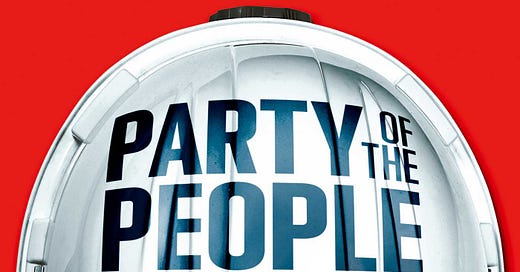Redefining the Right
How Republicans became the voice of the working class—and why it matters in 2024
(First, let me state emphatically that the following book review is simply that—a review. It is not an endorsement of either party’s candidate in the 2024 election. I’ve written previously about that topic; while the Democratic candidate has changed, my views have not.)
Party of the People: Inside the Multiracial Populist Coalition Remaking the GOP
By Patrick Ruffini
Grade: 97
“Anyone looking to better understand the 2024 election should read two books: Where Have All the Democrats Gone? The Soul of the Party in the Age of Extremes, by Ruy Teixeira and John B. Judis, and Party of the People: Inside the Multiracial Populist Coalition Remaking the GOP, by Patrick Ruffini.”
I’ve repeated those words often over the past several months. Though each book approaches the topic—our polarized politics—from different angles (Teixeira and Judis from the Left; Ruffini from the Right), both draw similar conclusions about how we arrived at this moment: Democrats ignored the working class and embraced progressive stances— i.e., defund the police, claiming America is racist, support for open borders, and a lack of focus on jobs and the economy—which opened the door for a Republican candidate who, willing to flout traditional party orthodoxy, prioritized immigration reform, trade, and patriotism while pushing back against demography-is-destiny rhetoric.
While the preceding paragraph could serve as a tl;dr of Party of the People, it would be a mistake to skip reading Ruffini's book. A Republican pollster, he provides a clear picture of how and why education has become as important in our elections as race, gender, and income.
“There is a natural working-class majority in American politics, and those who hope to lead the country ignore it at their peril,” he writes.
(I reviewed Where Have All the Democrats Gone? earlier this year.)
An eye-opening journey
Ruffini, a skillful writer and astute thinker, presents the most compelling case yet for how Republicans gained the ground lost by Democrats—a shift as remarkable as it was unexpected. Since World War II, the Democratic Party had been the home for working- and middle-class voters. But in the 1990s, the party began shifting its focus to globalization and environmentalism, distancing itself from labor and economic issues.
Republicans fill the void
Republicans, he writes, seized this opportunity by prioritizing issues aligned with working-class values, such as economic nationalism, immigration, and opposition to policies benefiting elites at the average American's expense. For example, Ruffini discusses how Republicans reshaped their messaging to address job losses from trade deals, cultural issues, and a disdain for bureaucratic status quos. Many recall similar populist themes from Pat Buchanan’s campaigns, but they failed to gain traction beyond a small percentage of primary voters.
Then, in 2016, the messaging finally stuck with the entrance of Donald J. Trump, the widely popular, bombastic entertainer.)
The former president snatched an opportunity Republicans would have otherwise missed
The former president disregarded the party’s post-2012 call to focus on immigration reform following Romney’s poor showing among Hispanic voters. Instead, Trump doubled down on the opposite message, advocating for a border wall and mass deportations. This strategy proved successful, resonating even with working-class Hispanic voters drawn to his focus on jobs and religious liberty—and on curtailing illegal immigration.
He saw an opening and ran with it, even as many within the GOP assumed he’d lose. His criticisms of trade deals like NAFTA and the TPP struck a nerve in Midwest states hit hard by manufacturing job losses. And his comments on undocumented immigrants taking jobs resonated in states like Indiana, Michigan, Wisconsin, Pennsylvania, and Ohio, where competition for employment was fierce.
Though Trump, a billionaire, might seem an unlikely figure to challenge coastal elites, his outsider status and no-holds-barred style made him a believable candidate to take on the Democratic Party, which many believed had been lost the Progressive Left (remember Bernie Sanders’ strong following) and forgotten its working-class roots. The 2020 election seemed tailor-made for Trump to counter the Left's new progressive stances. His appeals for national pride, support for law enforcement, and traditional American values clashed with the Dem’s focus on identity politics, defunding the police, and intersectionality.
What it all means
Since 2016, a lot has changed, but Trump’s support remains strong, with nearly half of the country supporting him. You often hear folks explain his supporters as “seeing him as the better of two undesirable choices.” I don’t believe that. What many people miss is the public’s generally low opinion of politicians. Trump’s supporters aren’t comparing him to VP Harris; they’re not even comparing him to an ideal Republican choice.
I think the rationale goes something like this:
“Sure, he might say crazy things, and me might even threaten to do crazy things, but at least he has the courage to take on issues other politicians won’t (see: trade, immigration, countering the Left's agenda, prioritizing America). He’s not just the best option; he’s the only option to achieve any of the things I care.
My opinion, formed over years and countless conversations, is also shaped by excellent books like this one.
Why you should read the book
Whether you’re a Democrat trying to understand how Republicans won over former constituencies, a Republican concerned about the party’s new identity, or an independent voter hoping to make sense of it all, Party of the People will not disappoint you. I’ve recommended it more than a dozen times and will continue to do so.





